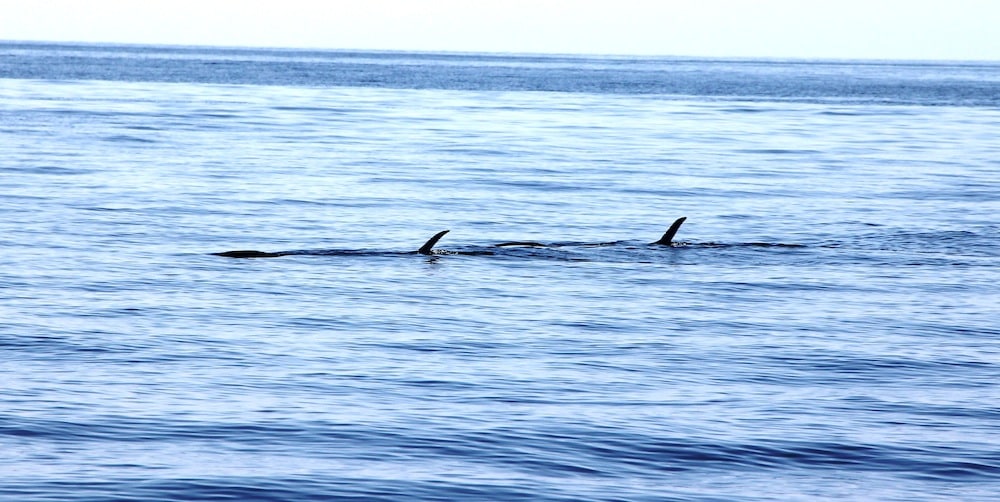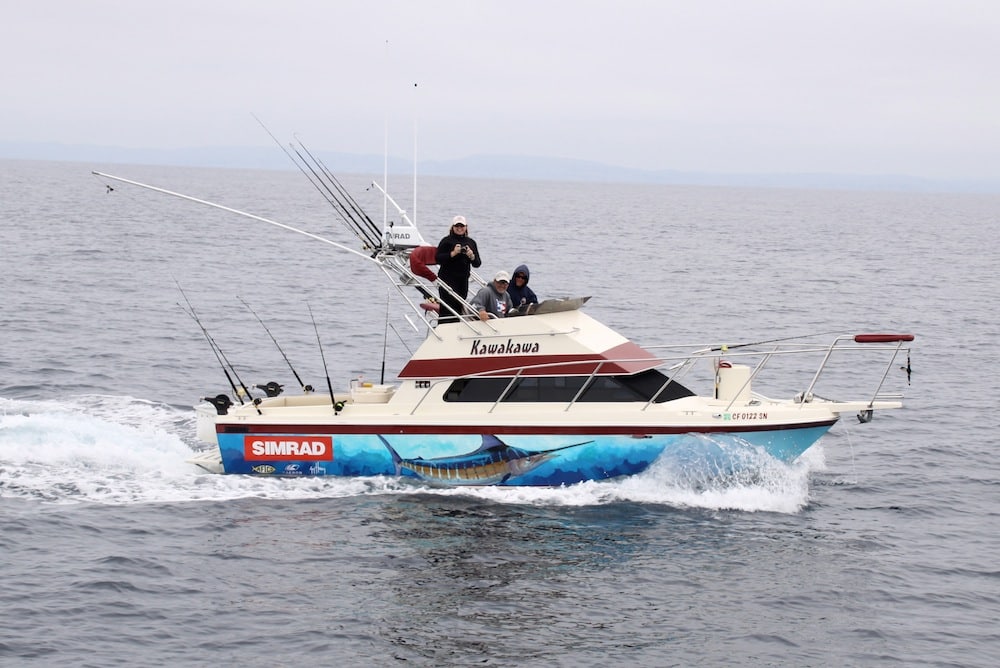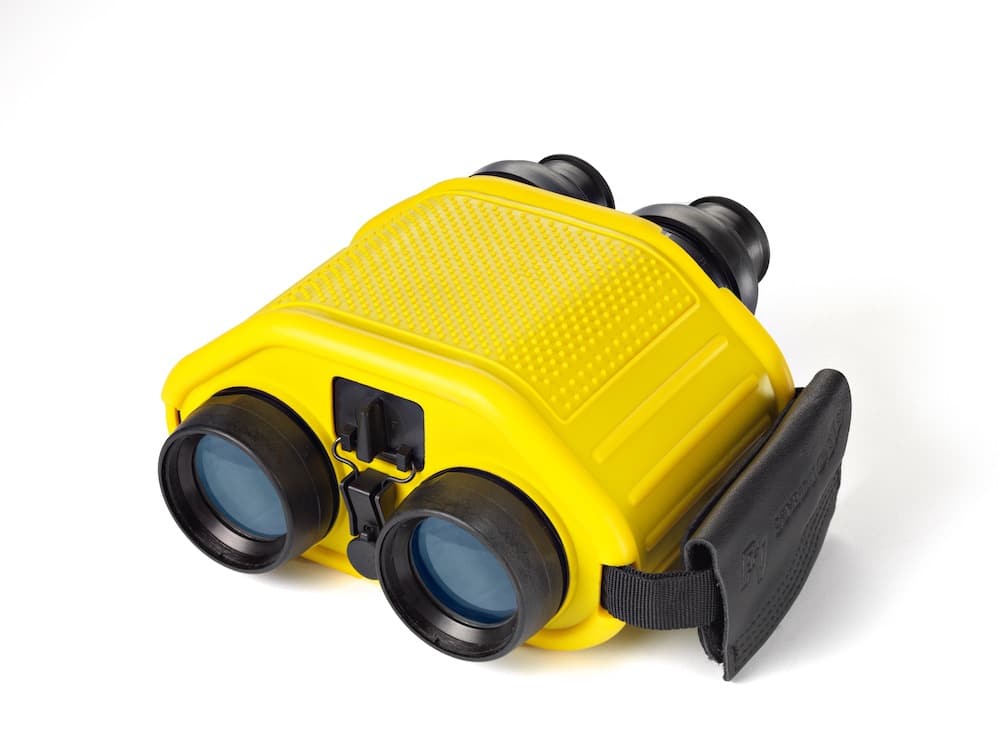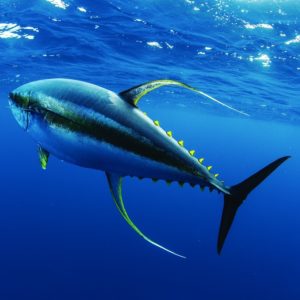
A pair of “tailers” — striped marlin at the surface
As we closed on a noisy flock of wheeling terns, I spied our target: striped marlin jumping clear of the water as they pummeled a school of baitfish below. Adrenaline sent tremors to my hands as I pinned on a live mackerel and lobbed it into the middle of the melee. Within seconds I was bit. With a count to five, I threw the reel in gear and set the hook. A 120-pound striped marlin went ballistic. We were on.
This is sight-fishing for striped marlin off Southern California — one of the most specialized, equipment-intensive and exciting styles of angling. It’s not always easy. Yet, when executed well, it can also spell the difference between success and failure, particularly when fish are not responding to trolled lures.
Keys to successfully sight-fishing for these beautiful, acrobatic billfish include teamwork, discipline, good eyes, polarized sunglasses, stabilized binoculars, an offshore boat with a flybridge or tower, specialized tackle, strong casting skills and live bait.
On the Hunt
Sight-fishing for striped marlin builds to a crescendo in the warm-water months of September and October off Southern California when this Pacific species often hunts, feeds, and relaxes near the surface. Yet there are tricks to finding these fish, which average between 100 and 150 pounds.
“We’re always on the hunt,” says Greg Stotesbury, who is national sales manager for California-based Aftco. He has fished Southern California offshore banks from his boat, Kawakawa [ITALICS], a 25-foot Skipjack convertible, for decades. No one knows the technique better than he and his brother, Michael Stotesbury; together, they won the Balboa Angling Club’s Master Angler Billfish Tournament twice (2006 and 2009). The all-release event is one of Southern California’s most prestigious marlin tournaments.
In this winning team, Michael devotes his time to scanning the distant waters with a pair of gyro-stabilized binoculars (see sidebar) for the tell-tale signs of marlin, while Greg usually mans the wheel and looks for fish closer to the boat. They usually have another angler in the boat, whose job is to watch the trolling lures and drop back a live bait if a marlin attacks the spread.
For the person using binoculars, comfort plays a critical role to minimize fatigue and lapses of concentration — factors than can allow marlin to slip by unnoticed. “Michael gets a bunch of pillows on the bridge to brace himself,” Greg explains. “And we have special elevated bucket seats with armrests to support his arms while he’s using the binocs.”
Maintaining an unobstructed view from the bridge or tower is also an important, but often neglected, element. For example, the Stotesburys keep all of the casting rods on the bow lying down with the rail-mount rod holders, angled horizontally so as not to block the forward view.
For anglers using their naked eyes, polarized sunglasses play a critical role, with top anglers carrying at least two pairs: one with amber lenses for cloudy skies and another with gray tint for sunny conditions. These help pierce the glare and allow anglers to see underwater, for not all marlin signs occur above the surface.
Sometimes you see a subsurface color spot such as a streak of blue, flash of silver or just a dark shadow, according to Gerg These are usually marlin that have turned and given away their locations.
Still, gyro-stabilized binoculars are more effective than the naked eye, particularly with marlin far from the boat. “My brother finds twice as many fish as I do,” Greg admits. “He’s seen fish as far as 3 miles away, and at 18 knots it takes only three minutes to get there — half the time, the fish is still up.”
Boat Tactics
When searching for striped marlin, the way you skipper the boat can improve your ability to find fish. The idea is to tack down-sea and down-glare, according to Greg “Tack back and forth down-sea as you’re trolling about 9 knots with sun behind you,” he explains. “This allows you to clearly see the backs of the waves, and that’s where the marlin often show themselves, tailing down-sea, especially in the afternoon.” Avoid trolling straight down-sea, as that causes the boat to go too fast, decreasing the chances that you will see a fish, he advises.
The Stotesburys network extensively with other marlin anglers in the days leading up to a trip to pinpoint the best offshore areas to focus their efforts. This might lead them to areas as close as an area known as “The 279,” 12 nautical miles off Dana Point, or the Mackerel Bank near San Clemente Island, 48 nautical miles off the coast.
Once they reach an area, they’re looking for more than just marlin. They’re also looking for signs of marine life — indicators that give them the confidence of finding striped marlin in the area.
“We’re looking for things like a flash, a swirl, a bird that dips suddenly, or a spray of baitfish,” Greg reveals. Another prime indicator is a sea lion that jumps in a tight arc known as “rainbow jumping.” This means the sea lion is feeding a tightly packed school of bait that California anglers call a meatball, and there could be marlin feeding on the bait as well.
As in most offshore fishing, birds serve as key indicators of fish. Off Southern California during marlin season (July through October), three species closely associate with striped marlin: terns, black gulls and jaegers. A dipping jaeger, in particular, is an almost-certain indicator of marlin.
“If I see any sign, you can bet I’m running straight for it,” Greg says. At this point, sight-fishing for marlin becomes a run-and-gun affair, as it is imperative to get to the action as quickly as possible. Often, the trolling lines are left out, the lures skipping behind, as the boat hustles to the action at 18 to 20 knots.
Greg is emphatic about turning and running on any sign, even something as small as single jumping baitfish, and then casting a bait to it. Sometimes it pays off with a blind strike from a marlin. If not, Greg marks each spot of activity on his Simrad GPS/chart plotter; this helps graphically define what he calls an “area of events.”
Once Greg finds such an area, he likes to stick with it, even if he hasn’t actually seen a marlin, betting on the assumption that the stripers will eventually show themselves. So after tacking through the area, he turns the boat up-sea and charges back to where they started, then spins the boat around and resumes the search. “Marlin cycle through the area in the same way,” Greg believes. “They turn around and swim back underwater, then begin tailing again once they’re in the life zone.”
Marlin Modes
Of course, sometimes you actually see marlin. In the gray light and calm waters of early morning, for example, fish are sometimes found hovering near the surface with their back and upper lobe of their tail out of the water. These are known as sleepers, and they often react negatively when presented with a live bait, as if perturbed that you woke them for breakfast.
Later in the day, when the breeze picks up, striped marlin like to surf the waves while hunting. It’s known as tailing, as you often see the upper lobe of the tail slicing through the backside of a wind wave. This behavior allows them to conserve energy while looking for prey. Tailers usually respond well to a frisky live bait such as a Pacific mackerel.
You also might see a free-jumping marlin, sometimes unleashing four or more jumps in a row. Jumpers, as they are known, move fast, and it’s tough to catch up and present them a bait, though sometimes they settle down and begin tailing.
Every once in a while, you’ll come across one or more marlin, as described earlier, attacking a school of baitfish. You can usually spot feeders from afar, as the lit-up fish often jump out of the water to pounce on the meatball from above. The commotion generates white water and usually attracts a bunch of birds. These fish rank as the most aggressive of all. Usually, casting a live bait anywhere close to feeders is like rolling a wine bottle through a jail cell — it gets picked up quickly.
The most common surface behavior is tailing, and different anglers have different methods for presenting baits to these marlin. The traditional method is to parallel the fish, placing the boat to right side of the marlin (assuming a right-handed angler). With the fish in the 9 o’clock position, an angler on the bow casts a live bait underhand so it lands just in front of the marlin.
Greg however, likes to split the difference. For both tailers and sleepers, he tries to place the fish in the 10 o’ clock position (2 o’ clock for left-handers) with the fish a boat’s length away. “All of my ‘castaleros’ throw the bait underhand for minimum splash on sleepers and flat-water tailers,” he explains.
“I keep the boat moving as the cast is happening; I don’t stop the boat,” Greg says. “We always double-bait a fish, as marlin almost always travel in groups, and double hookups are not uncommon.” If they don’t get bit, the casters walk back to cockpit to slow-troll the bait.
Live Act
This kind of fishing requires lots of live bait, but not just any bait. A 6- to 8-inch Pacific mackerel (known locally as a greenie or greenback) ranks as the most effective live bait for Southern California marlin. Second choice is a live Pacific jack mackerel (known locally as a Spanish).
Most marlin fishermen catch their own live bait using Sabiki rigs, sometimes stoking cavernous, cockpit-mounted livewells days ahead of time. It’s not unusual to find a big sport-fisher carrying 100 or more live mackerel for a long weekend of fishing. Most marlin boats also have a smaller livewell on the foredeck, as many anglers cast to marlin from the bow.
The Stotesburys bridle their baits through the nose ahead of time for casting. Bridling helps keep the bait as lively as possible, a key factor in attracting the attention of striped marlin. Their favorite light-tackle hooks are 6/0 to 8/0 Owner Aki nonoffset J hooks. Greg says they almost always hook marlin in the roof of the mouth.
Light tackle is the order of the day for the Stotesbury team, which casts with 12-, 16- and 20-pound-test monofilament main line with 60- to 80-pound-test fluorocarbon leaders. A Bimini twist to a Uni-knot splice connects the main line to the leader, with a Spro barrel swivel tied in with Uni-knots about three feet above the hook to keep the leader from twisting as the bridled bait swims in the livewell.
Live-bait rods for marlin possess distinctive traits. Most are 7 to 8 feet in length, with a parabolic action and Fuji 18- or 20-size ring guides and an Aftco Roller ring tiptop that allows knots to pass through unfettered when casting. Greg prefers a Shimano Torsa 16N for light-tackle marlin fishing.
Setting the hook on a marlin when fishing live bait is also a unique experience — a collaboration between angler and skipper. Once a marlin grabs the bait, the angler notifies the skipper that he’s bit, but keeps the reel in free-spool. After a five-count, the angler puts the reel in gear and points the rod at the fish, while the skipper briefly accelerates the boat. If all goes right, the line draws tight and begins peeling off the reel, indicating he fish is hooked.
Marlin anglers in Southern California rarely back down on fish. Instead, the angler usually stands up to fight the fish from the bow pulpit, while the boat follows it going forward. Alternately, the angler may stay in the cockpit, but remains standing, while the skipper keeps the fish at the 10 to 11 o’clock position and follows bow first.
For the end of the fight, an angler on the bow often makes his way aft to make it easier to leader and tag the fish, and get one final sighting — and a few photos — before the release.












